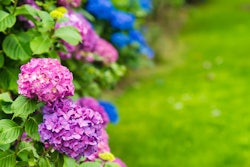
It might surprise your customers to find out which of these creepy crawlies are actually serving a bigger purpose in their yard, so take a look at why exactly these specific insects should be left to their own devices.
Bluebottles and beetles
Bluebottles can be found on fruit tree leaves, and the purpose they serve is to clean these plants of pesky aphids that were leaving leaves sickly-looking.
The feeding habits of these flies help break down food waste while simultaneously pollinating plants in the process. Predators of bluebottles include toads and frogs, spiders, birds, and bats.
Most of the time, customers may have a hate-hate relationship with the idea of having beetles in their landscape, but let’s not rule them out just yet.
As the largest insect group, beetles are usually met with criticism by most customers, but that’s not the case with every type. Ladybugs, for instance, are one beetle type that most of your customers wouldn’t mind seeing more of in their garden.
Ladybugs, for customers unaware, are toxic to birds, however, they serve a vital role in the food chain because of their love of aphids as a tasty snack. It’s true that if your customers are vigilant enough when out in their landscape, they could get rid of appearing aphids by simply squishing them, but is that really the course of action you think they want to take?
Plants that suffer a small amount of aphid damage aren’t necessarily marked for death, but their resulting sap could possibly attract ants, as well as produce mildew. If your customers notice a larger population of aphids in one area of their landscape, encourage them to possibly introduce a few more ladybugs into the situation to help out a plant in need.
Predators of beetles include reptiles, frogs, some birds, badgers, foxes, rats, and bats.
Wasps, bees, butterflies, and moths
It’s no secret that most of your customers, and maybe you as well, are pretty hesitant to deal with wasps when they appear in the landscape, but they actually are helpful when it comes to helping break down organic matter. If it weren’t for the wasps coming and going across the yard, any unharvested foods would take much longer to decompose.
Most customers wouldn’t typically consider bees, butterflies, and moths to be “pests” or troublesome in a landscape, but since they are, indeed, insects, they make the list.
Butterflies, bees, and moths serve as important pollinators in the landscape, and much like their friends the flies and wasps, they too will stop and drink from decaying fruits for nutrients.
Most butterflies and moths rely on thistles and nettles to use as breeding grounds, so communicate to customers that it’s okay to have a few weeds growing around for this purpose. While it may have ‘weed’ in the name, milkweed is actually a wildflower, and having a healthy presence of them can be one of the biggest attractants for butterflies.
If your customers prefer to keep these weeds out of sight and out of mind, consider adding them in behind a garden shed or near a compost heap so they don’t detract from the manicured look of the yard.
To find out more about attracting butterflies to your customer’s landscape, click here. For ideas on different plants you can incorporate into your customer’s landscape to bring in more butterflies, click here.
Woodlice, centipedes, and earthworms
Now, these are the kind of insects that are typically associated with the term creepy crawlies, and it can be hard at first to convince customers that these insects can be helpful, even if they are unpleasant to look at.
These types of invertebrates can be very helpful when it comes to composting and decomposing, as they work hand-in-hand with bacteria and fungus to accomplish these tasks.
While these insects do have enemies such as grass snakes and toads, the centipede is also known to eat woodlice.
Lacewings and hoverflies
Much like their friend the ladybug, lacewings, and hoverflies are typically seen as predators instead of a source of food for others. Hoverflies tend to confuse predators and people, as they look to be a combination of a horsefly and a wasp.
Lacewing larvae, much like those of ladybugs and hoverflies, will eat aphids until the cows come home, and as an added bonus, lacewing larvae have been known to eat spider mites.
Click here to read even more beneficial bugs to have in the landscape.












